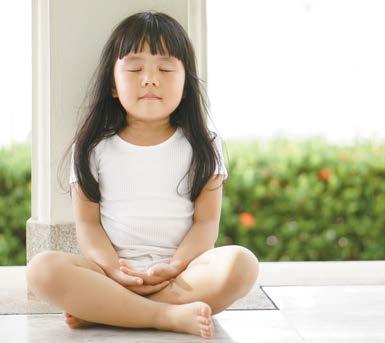
4 minute read
healthy kids
Relaxed Kids
Simple Ways to Calm Anxious Children
Advertisement
by Sandra Yeyati
kornnphoto/AdobeStock.com
It doesn’t take a full-on tantrum for children to experience or exhibit stress. According to licensed school psychologist and spiritual counselor Zemirah Jazwierska, anxiety is a child’s natural response to not having consistency or predictability in their environment. During the pandemic, with school closings, social isolation and associated challenges, childhood angst is on the rise, says the Boulder, Colorado, blogger at KidsRelaxation.com.
Setting a Calm Example
Jazwierska believes that it’s never too early to expose kids to relaxation practices. She invites moms to incorporate meditation even while they’re pregnant, “to bathe their little babies in lots of good-feeling hormones and chemicals.” After birth, while an infant may be too young to learn how to meditate, she recommends that parents create relaxing home settings where impressionable kids will naturally learn to chill out. “Babies are continually sensing their environments,” she says. “Just speaking in a calm voice or slowing down the pace of life, taking time to connect or practicing infant massage can prime their little minds and bodies for learning how to self-regulate, cope with life and default to relaxation mode just as soon as they feel stressed.”
Benefits of Kid Relaxation Techniques
From breathing games and animal-like yoga positions to meditative art activities and mindful nature walks, child-friendly relaxation techniques are limited only by our imagination. When practiced consistently, they offer numerous benefits, including increased awareness, attention, empathy, resilience and generosity; less emotional reactivity; and improved memory, according to Whitney Stewart, meditation teacher and author of Mindful Kids: 50 Mindfulness Activities for Kindness, Focus and Calm (BarefootBooks.com/ mindful-kids).
Getting Started
Stewart recommends that parents and caregivers consider adopting their own mindfulness or meditation practices before introducing them to their children. “The next step could be to invite children to practice with you,” she advises. “With toddlers, this may be an invitation to sit or lie down with hands on their tummy or chest to let them feel their breath coming in and going out of their body. Young children don’t always have an awareness of their breath. Parents and caregivers can help them understand how we breathe in different situations; how breath can speed up or slow down in response to our physical and emotional state.”
Making Relaxation Fun
According to Stewart, small children respond best to mindfulness exercises that are both physical and fun. Her Animal Antics is one example, in which kids explore movement meditation by pretending to be different animals. Another is Shake
the Sillies Out, which involves “happyshaking until you finally flop on the floor with a deep exhalation, followed by three mindful breaths. This one really helps work out kids’ excess energy,” she says.
On her website, Jazwierska offers myriad examples of fun and creative activities to calm and awaken children. She teaches breathing techniques by offering imagery kids can understand, like smelling a flower to learn deep inhalations and blowing out a candle for the exhalations. When kids are overcome with strong emotions, she offers a snow globe. “It’s a great tool for seeing how things start to swirl when our emotions are too strong and our minds too worried. As you take a deep breath and stop moving the globe, the snow settles. We have to stop moving, or move very slowly, for everything to settle for ourselves.”
Jazwierska’s Rock and Floppy Sock exercise instructs a child to make a tight fist— the rock—when they feel anger or another strong negative emotion, and then release their grip, turning it into a floppy sock. “It’s related to progressive muscle relaxation where you provide tension in the body and then you provide the contrast and let go, training the mind. Next time they feel tension, they’ll know how to relax,” she says.
Planting Seeds for Inner Happiness
As children grow older, they can add visualization to their repertoire, like Stewart’s Heart Garden exercise, in which the child sits mindfully while relaxed, takes three mindful breaths and then thinks of a word that makes them smile. “That can be anything—like butterfly, rainbow or watermelon,” she explains. “Imagine planting that word like a seed in your heart. Repeat the word and imagine watering the seed in your heart garden. Repeat the word and imagine the seed opening and growing in your heart. What does it become? See it blossom. True happiness comes from inside. Everyone can plant their own inner happiness.”
Sandra Yeyati, J.D., is a professional writer. Reach her at SandraYeyati@gmail.com.
Access the Record of Your Soul’s Journey Find Your Life Mission

For additional information – www.akashicrecordconsultantsinternational.org
AKASHIC RECORD CONSULTATIONS
By Stephany “Stevie” Levine ARCI Trained Certified Consultant/Teacher Over 8 years of experience







